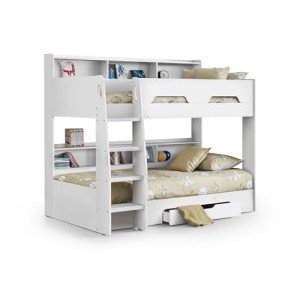Bunk Beds for Kids: A Comprehensive Guide
Bunk beds have been a popular option for kids's bed rooms for years. They use a space-saving solution that makes the most of floor location, supplies enjoyable climbing up options, and comes in a variety of styles that interest kids's creativities. This short article explores the advantages, considerations, styles, and safety functions associated with bunk beds for kids.
Benefits of Bunk Beds
Bunk beds present multiple advantages that make them an attractive option for households. Here are some essential benefits:
Space Saving
- Bunk beds allow 2 or more children to share a space without compromising space for play or other activities.
Cost-Effective
- Acquiring a single bunk bed can be more cost-effective than purchasing two separate beds.
Fun Factor
- Kids frequently see bunk beds as an enjoyable location to sleep and play, cultivating a sense of experience.
Versatility
- Bunk beds are offered in various setups, consisting of L-shaped, loft beds, and even convertible styles that can alter as kids grow.
Organization
- Numerous bunk beds include integrated storage options, such as racks and drawers, helping keep rooms organized.
Key Considerations Before Purchasing
Before buying a bunk bed, it's necessary to consider specific factors, such as:
- Space Requirements
Procedure the room to guarantee that there is sufficient vertical space, permitting for adequate headroom on the top bunk. - Age of Your Children
Consider their age and maturity. Numerous makers recommend that kids under 6 need to not sleep in the top bunk due to security issues. - Weight Limit
It's essential to check the weight limitations of the bunk bed for both the leading and bottom bunks to ensure safety. - Design Preferences
Choose a style that matches the space's decoration and the children's preferences. - Product
Bunk beds are available in different products, such as wood or metal. Each has its advantages and disadvantages concerning durability and aesthetic appeals.
Styles of Bunk Beds
Bunk beds come in numerous designs to fit different visual appeals and functional needs. Here's a list of some popular styles:
- Standard Bunk Beds
Timeless stacked beds that consist of 2 beds developed one above the other. - Loft Beds
A bed elevated high off the ground, with space below for a desk, play area, or storage. - L-Shaped Bunk Beds
Two beds set up in an L-shape, offering more floor space and a distinct style component. - Twin Over Full Bunk Beds
These alternatives include a twin bed on leading and a full-sized bed on the bottom, accommodating older children or adults. - Triple Bunk Beds
Designed for 3 children, these beds generally include 3 stacked beds, ideal for larger families.
Safety Features to Consider
Making sure the safety of children using bunk beds is critical. Here are some safety includes to look for before making a purchase:
- Guardrails
A bunk bed need to include durable guardrails on the leading bunk to avoid accidental falls. - Ladders
Guarantee that the ladder is firmly attached and simple for children to browse securely. - Stability
Try to find bunk beds with lower centers of gravity and wide bases to supply much better stability. - Quality Construction
Pick beds made from long lasting products that fulfill security standards, such as ASTM (American Society for Testing and Materials) guidelines.
FAQs About Bunk Beds
1. What age is proper for a leading bunk?Generally, kids aged six and older are advised for oversleeping the top bunk. 2. Are bunk beds safe for toddlers?Most specialists recommend against
placing toddlers in the leading bunk due to the
danger of falls and incorrect ladder usage. 3. Can bunk beds be separated?Many bunk beds are developed to be separated into two standalone beds,
providing added flexibility as children grow
. 4. How do I keep a bunk bed?Regularly check for loose screws and wear, keep mattresses tidy, and make sure that the bunk bed is
steady to extend its lifespan. 5.
Exist any special bed mattress requirements for bunk beds?Yes, mattresses for bunk beds must fit snugly without leaving spaces. Generally, thinner mattresses
(around 6 to 8 inches )are advised for top bunks for security. Adult Bunk Beds provide a flexible, useful, and enjoyable solution for kids's sleeping plans, taking full advantage of space while accommodating several kids in one room. By considering the crucial factors
of style, safety, and space, moms and dads can make an informed choice when picking the ideal bunk bed for their kids's requirements. With the ideal care and maintenance, a bunk bed can be a beloved piece of furniture that offers years of use and satisfaction for children. Summary Table of Bunk Bed Styles Design Description Best For Standard Bunk Beds Timeless design, 2 stacked beds Smaller sized spaces Loft Beds Raised bed with open space beneath Research study or play locations L-Shaped Bunk Beds Two beds in an L-shape
Included flooring space Twin Over Full Twin on top,
| complete on bottom Accommodating older children Triple | ||||||
|---|---|---|---|---|---|---|
| Bunk Beds | 3 stacked beds | Bigger families By comprehending | the numerous alternatives readily available, designated considerations for safety and performance, and proper age guidelines, households | can pick the ideal bunk bed that not | only improves their living space | however likewise makes sure a safe and |
| satisfying sleeping environment | for their children.

|
